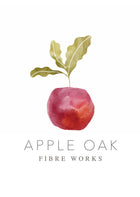Can I mordant Cellulose with milk/soya milk?
The question of "Can I mordant with milk or soya milk?" comes up regularly during a workshop and is a very interesting one to have a closer look at. Mordanting, the process of preparing fabric for dyeing, typically involves the use of metallic salts. However, many dyers are exploring alternative mordants, such as dairy-based products like milk or the vegan soya milk alternative.
While traditionally used mordants like alum and iron are known for their reliability and effectiveness, there is ongoing experimentation to discover new methods. Milk and soya milk, with their high protein content, have been theorized to potentially act as natural mordants, but are, strictly speaking, more of a binding surface treatment. Let's have a closer look!
As much as we enjoy considering milk as a 'new' way, it was already used traditionally as a pre-treatment for cellulose fibers in India and Turkey. In India, it was mixed with Chebule or better known as Myrobalan, while in Turkey milk was used as a stand alone. The question remains, though, are those effective?
By looking deeper into the processes, it is quite apparent, that milk or soya milk, will only attach to the outside of the textile and therefore create a coating to 'fool' the dye to attach to protein. Both, milk and soya milk, are rich in protein and enzymes and will therefore create a perfect bonding material. So, what is the problem?
We should keep in mind, that both applications were used on textiles used in the carpet industry rather than in the fashion industry, at least in Turkey. Therefore, washing was kept to a minimum and this were the answer lies.
Both, milk and soya milk, are fantastic for textiles that do not require washing. Canvases, wall hangings, textile art you name it. They create a strong bonding surface, that will span decades when used with the correct natural dye material and will work particularly well with natural paints.
However, they are unsuitable to use as a mordant replacement, when dyeing items that need washing. Naturally, if you dye for yourself or friends and don't mind re dyeing items on occasion, by all means, go for it! But in a professional dyeing practice when dyeing for wearables, neither milk should be used.

Soya milk, unlike cow milk, also contains small amounts of tannins, which would make it the better overall choice. Giving today's dairy industry and its challenges and impact on the planet, I would suggest using soya milk exclusively. Always make your own milk, by soaking dried soya beans in water, blending it the next day and strain it. Shop bought can also be used, but the protein content is lower and you have to look out for added sugar and/or preservatives. Below you will find a couple of recipes to use for textile preparation. Enjoy!
Traditional Turkish recipe:
1. Soak Textile in Water 12-24h.
2. Add the wrung out or spun out textile to the soya milk.
3. Lift textile in an out to get an even coating on the surface.
4. Hang to dry, speed it up by using a hair dryer, if necessary.
Repeat 3-5 times and store the dried textile for curing, for one week.
Proceed with application of colour, leave to cure for 2-3 days.
Rinse gently but thoroughly and dry.
TIP: Soya milk turns within 2-3 days, make sure you get your dips in before and store it cold in between dips, if possible.
Traditional Indian recipe:
Traditionally, the tannin solution and diluted milk were added to the same tannin bath, but you can also apply them separately. For the tannin solution, Myrobalan was used, an ellagic tannin (yellow colour); but you could also use oak galls for a less colourful background, but similar strength in tannin content.
Soak Textile in Water 12-24h
Create a tannin bath for your pre-soaked textile:
1. 10-30% of oak gall added to warm water.
2. Add textile.
3. Leve for a minimum of 2h.
Create Soya milk bath for your pre-soaked textile:
1. Add your squeezed out (do not spin out) tannin soaked fabric to the soya milk bath.
2. Lift textile in an out to get an even coating on the surface.
3. Hang to dry, try to dry it quickly, because the soya milk and tannin combination will turn even quicker then the stand alone soy milk application. See first recipe for tips.
Repeat 2- 3 times and store the dried textile for curing, for one week.
Proceed with application of colour, leave to cure for 2-3 days.
Rinse gently but thoroughly and dry.
These recipes were used on cellulose only and were particularly popular with Madder applications. Thank you for reading and good luck with your textile! :)
Join The Natural Dyers Academy for more articles and info unlocking April 2024



Hi Jeanne, you are very welcome! There is a lot of info out there and sometimes it can be very confusing. I love dyeing embroidery threads, there are very easy and straight forward :)
Thank you for this post! I am new to fiber-dyeing, and it’s very helpful to have the recipes, and to know that this method is not best for washable fibers. At the moment I am experimenting only with embroidery threads.
Leave a comment